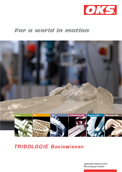OKS lubricants – highest performance for maximum process reliability
Numerous test methods are used to examine and evaluate the various influencing variables of a tribological system for the development and quality assurance of lubricants. The collected characteristics describe the chemical/physical properties of a lubricant which allow statements about its possible suitability for a specific application.
Flashing point
The flashing point is a measurand at combustible liquids which allows the danger of fire to be assessed. Depending on the product type and height of the flashing point to be expected the most common measuring methods are closed crucibles (to DIN 51 755) or open crucibles (to DIN ISO 2592).
Thread friction
The thread friction is determined on a screw test bench. According to DIN EN ISO 16 047 the coefficient of friction μ of a screwed connection is obtained when screws and nuts are tightened. Thread dimension, materials and type of the surface have to be specified.
Condensed water test
The condensed water test is one of several examinations carried out to assess a protective layer as corrosive influences (DIN 50 017 – KTW condense water temperature alternating climate) and defines the test procedure in a climatic chamber at alternating climate. The result is the number of hours until traces of rust arise.
Consistency
The consistency of a lubricating grease is measured with a penetrometer to DIN ISO 2137 whereby the grease is worked before measuring in order to imitate the stress in a bearing. The penetration depth of a cone allows the allocation to a consistency class to NLGI (DIN 51 818).
Breakaway behaviour
Breakaway behaviour, the ratio of the loosening torque to tightening torque, is determined for high-temperature screw pastes after screws M10 (or M12), material A2-70, have been tightened with 40 Nm (or 70 Nm) and have been subjected to a temperature between +200 °C and+650 °C for 100 hours.
Pour point
The pour point of an oil is measured to DIN ISO 3016. It lies some °C under the recommended lowest operating temperature.


